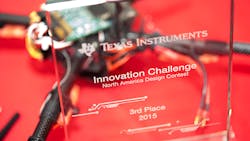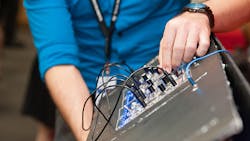Design Competition Tests Students While Exposing Them to Employers
While engineering internships serve as the main entryway for students into the job market, design competitions have the potential to be an important supplement to their education, especially as companies have struggled in recent years to find qualified candidates with actual technical experience.
Texas Instruments (TI) recently honored student projects submitted to its 2015 North American Innovation Challenge, with entries judged primarily on their level of engineering analysis and their use of TI integrated circuits. The competition encouraged students to work through all levels of the design process, from the concept stage to sourcing components for their projects.
Troy Bryan and Sean Lyons, recent electrical engineering graduates from the University of Florida, were named the overall winners for their project—a synthesizer that can be played with hand movements rather than a keyboard. The project, 7 Deadly Synths, employed 12 infrared beams that detect hand movements and correspond to musical notes. The instrument, which was designed for musicians with limited mobility, is connected to both analog and digital synthesizers, making noise as the musician moves his hand through the infrared beams.
A team from the University of Texas at Dallas was awarded second place in the competition for its sign-language recognition system. The wearable device is equipped with inertial and surface electromyography sensors that translate the movements of sign language into text displayed on a computer screen.
Third place was taken by an autonomous GPS flight system for quadrotor unmanned aerial vehicles (UAVs). Other finalists included a wireless anti-theft device for bicycle locks; a golf putter that provides real-time feedback on putting motion; an educational tool for engineers studying the smart grid; and a low-power ac plug load meter.
By focusing on engineering practices, competitions like the TI Innovation Challenge provide students with an opportunity to engage with potential employers. The nature of the competition enables students to demonstrate that they have experience with the components and systems used in their designs—or at least cultivate a better understanding of this technology.
This kind of practical experience is increasingly important in the eyes of employers, especially as the job market grows more competitive, training gets more specialized, and it becomes more difficult for engineers to stay updated on new technologies. According to TI Innovation Challenge literature, participants were evaluated not only in the context of the competition but also for a possible career with the company.
The Innovation Challenge, which is managed by Texas Instruments’ University program, represents an ongoing initiative by chipmakers to interact with both students and potential job candidate through educational programs. These programs, such as ones founded by Intel and Xilinx Inc., give students access to learning materials, components, and reference designs for teaching and research. In the process, students become more familiar with the company’s products and design approach, which has the potential to ease their transition into an engineering position or internship.
Over the last year, the TI Innovation Challenge accepted submissions from almost 300 teams at accredited engineering colleges and universities in the United States, Canada, and Mexico for the North American competition. TI also runs design competitions in India, China, Europe, and the Middle East to extend its search area for potential engineers. The 2016 North American TI Innovation Challenge will open in September to eligible contestants.
About the Author
James Morra
Senior Editor
James Morra is the senior editor for Electronic Design, covering the semiconductor industry and new technology trends, with a focus on power electronics and power management. He also reports on the business behind electrical engineering, including the electronics supply chain. He joined Electronic Design in 2015 and is based in Chicago, Illinois.



